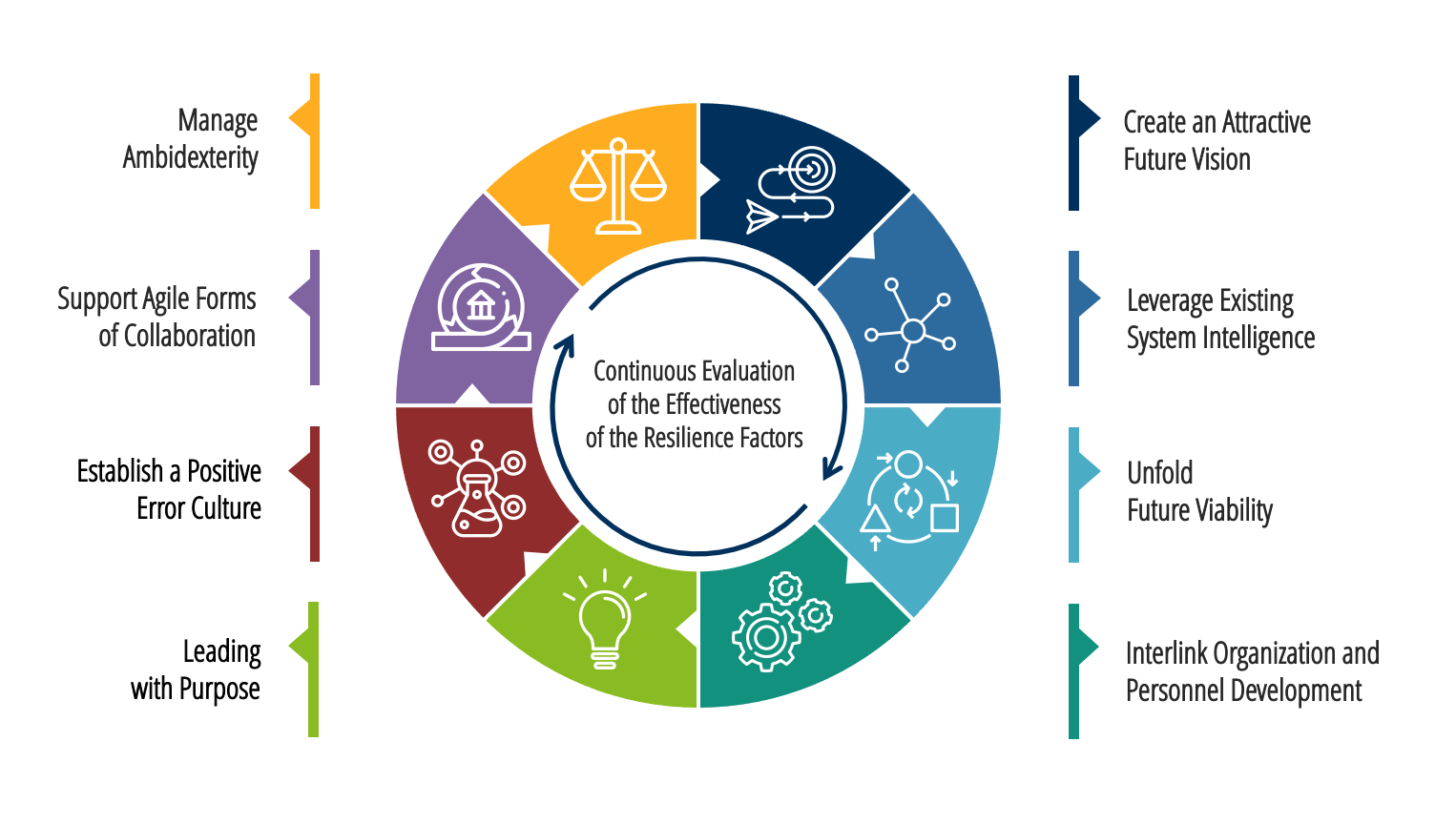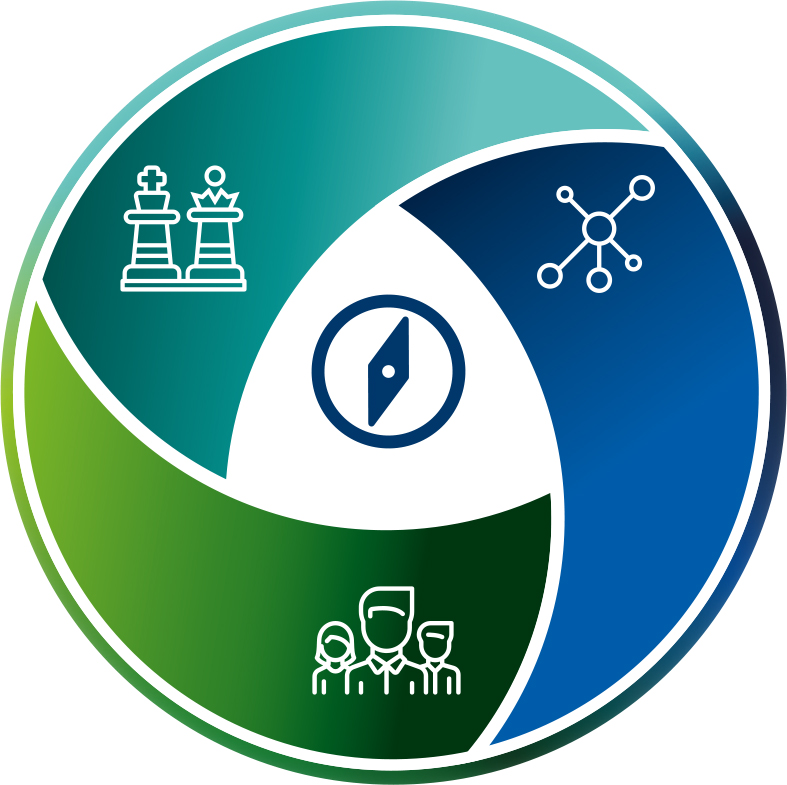Organizational resilience
Organizations that want to survive successfully under the volatile conditions of today's business world must be able to withstand the tension between stability and flexibility. They should recognize risks, opportunities, and vulnerabilities at an early stage and be able to harness internal and external impetus for change. Organizational scientists refer to these capabilities as organizational resilience.

Organizational resilience
Organizations that want to survive successfully under the volatile conditions of today's business world must be able to withstand the tension between stability and flexibility. They should recognize risks, opportunities, and vulnerabilities at an early stage and be able to harness internal and external impetus for change. Organizational scientists refer to these capabilities as organizational resilience
Organizational resilience - Definition
Essential principles, attributes, and development processes of resilient organizations have been summarized by the International Organization for Standardization. The corresponding standard contains a definition of organizational resilience:
“Organizational resilience is the ability of an organization to absorb and adapt to changes in relevant environments in order to achieve strategic goals, evolve, and remain viable in the future. Resilient organizations can anticipate, mitigate, and capitalize on opportunities and threats that arise from sudden or gradual changes within and outside the organization.”
– ISO-Norm 22316:2017, freely translated by S&P
Importance of organizational resilience
No organization can avoid crises – the Corona pandemic has shown us in fast motion what can happen when organizations can no longer keep up with the dynamic developments in their relevant environments.
The ability to deal quickly and flexibly with changing conditions has been considered a key success factor for organizations for a long time. The requirements in sales and procurement markets are changing constantly and with increasing speed. Digitalization and the complexity of markets have greatly accelerated innovation cycles. Organizations are challenged to develop new and creative solutions in the face of fierce competition in order to continue to meet the needs of their stakeholders.
Often, management is already doing a very good job here and developing promising concepts. However, these ongoing adaptation processes cost the organization a lot of energy. Frequently, hoped-for results are not achieved or are again in question immediately after they have been consolidated in organizational value creation processes. This leads to cynicism and change fatigue among managers and employees.
Resilient organizations manage these change and adaptation processes with greater ease by leadership focusing on the right conditions for adaptation and change capability.
Strengthening organizational resilience
The development of organizational resilience affects all organizational areas and cannot be realized without a coordinated strategy, organizational, and human resources development. Strategy topics, the areas of Organization and Human Resources, as well as Leadership and Culture, are interdependent and an isolated consideration of individual fields, especially with regard to the development and maintenance of organizational resilience, is not expedient.
As systemic organizational consultants, we have special experience in working on these interdependencies within an organization. We support companies in orchestrating factors and action fields of organizational resilience in a targeted manner.
Factors and action fields of organizational resilience

© 2023 S&P Consulting

Creating an attractive future vision
An authentic future vision strengthens organizational resilience. Focusing on a desirable future vision that takes the emotions in the company seriously unfolds an action-guiding orientation for collaborative processes and is thus a driver for innovative organizations.
A well-communicated and operationalized future vision clarifies the contribution of individual organizational units and employees to the achievement of strategic goals and, therefore, unleashes tangible performance incentives.

Leveraging existing system intelligence
Resilient organizations use existing system intelligence to shape the future and manage uncertainty by interlinking internal and external knowledge when dealing with future issues.
Both in making hypotheses about future developments, in deriving, and evaluating opportunities and risks, and in developing an attractive and viable future vision.

Developing future viability
Organizational resilience requires, in addition to meaningful leadership, the establishment of suitable structures and routines for foresighted self-renewal, which strengthen resilience and adaptation with regard to external and unexpected influences.
Leaders will increasingly need to keep an eye on changes in the organization’s environment and align them with structures and routines within the organization. In the future, the primary task of leadership will no longer be to maintain regular operations, but rather to ensure irritation, deviations, and constant questioning of the path taken.

Interlinking personnel and organizational development
Organizations that succeed in interlinking human resources and organizational development are able to manage change and deal with uncertainty and growing complexity with greater ease.
Learning architectures need to be established to enable coordinated personnel and organizational development. Particular importance is attached to interface management for intensive networking between managers, teams, and departments.

Leading with Purpose
Resilient organizations depend on employees who are able to classify and question the meaning of their activities within the framework of the organizational value chain. Accordingly, meaningful leadership – in line with the requirement for New Work – also becomes central to the resilience of organizations.
Employees today need and want to understand why they are doing a particular job. In this context, it is not enough to explain a work order and its meaning well. Ideally, the goals of an organizational area are developed together with the team and its contribution to value creation is defined collaboratively.

Establishing a positive “error culture“
Resilient organizations literally create spaces to try out new methods of collaboration, new architectural concepts, and innovative processes. In the process, it is clear that anyone who tries out new things also makes mistakes. Accordingly, organizational resilience requires defined zones of error tolerance as well as the promotion of psychological safety in collaborative development processes.
This creates an atmosphere in which employees can learn from each other, expand their skills together, and thus also develop personally.

Supporting agile forms of collaboration
In resilient organizations, control and steering are replaced by agility and flexibility, which enable organizations to deal proactively, permanently, and appropriately with constantly changing requirements. Organizational agility does not unfold solely through the establishment of modern and agile methods:
An organization is agile and capable of innovation if it has the organizational competence to recognize uncertainty with regard to a required solution as well as a corresponding solution path and to use agile working methods for these challenges in a targeted and skillful manner.
This also includes being able, depending on the situation, to set up or dismantle structures that allow and support agile ways of working.

Managing ambidexterity
Resilience at the organizational level requires ambidextrous competencies that can guide an organization safely through crises on the one hand, and prepare it for economic recovery on the other.
Ambidextricity (from Latin: ambo – both; dexter – right, i.e. “ambidexterity”) describes the organizational ability to simultaneously efficiently manage and constantly optimize today’s business (“exploitation”) and, on the other hand, to recognize potential and develop innovations (“exploration”).
It becomes an essential management task to manage the balance between “exploitation” and “exploration” and the associated paradoxes with regard to resource allocation, jobs and working conditions for employees of the core business and an innovation wing – as well as their structural coupling.

Constantly evaluating the effectiveness of the resilience factors
In resilient organizations, it is essential to establish structures for continuous monitoring of the effectiveness of resilience factors. On the one hand, this involves establishing observation criteria and patterns that make it possible to monitor not only the implementation of measures but also their effectiveness.
In addition, it is important to establish routines that go beyond the specific need for development and the reason for the change to show how the organization has dealt with change in the past and whether these established patterns themselves need to be changed.
In this sense, the organization uses occasions for change to critically reflect on previous solution patterns from a meta-position and, if necessary, to find and establish new change patterns.
Arrange a free online dialog with S&P consultants and
learn how to strengthen the organizational resilience in your company.
 Frédéric SedlákSenior Consultant | HR Management
Frédéric SedlákSenior Consultant | HR ManagementWe are always at your service+49 4102 69 93 22
Ask for free informationf.sedlak@spconsulting.de
Holistic systemic organizational consulting

Strategy
Develop a strategy with us to actively and successfully shape the future, even in times of uncertainty.
Organization
Together with you, we will answer the question of which organization your organization needs.
Personnel
Ensure the long-term performance of your organization with innovative HR solutions.
Leadership
Establish a form of leadership that enables constant organizational adaptation to the challenges of the times.
Culture
A culture that fits the strategic goals of an organization significantly increases organizational performance.
Concrete consulting services related to organizational resilience
Contact Options
If you would like to learn more about us and our consulting approach, we look forward to a personal conversation with you! Simply make an appointment with us.

Online
Make a non-binding inquiry and specify your expectations
 Frédéric SedlákSenior Consultant | HR Management
Frédéric SedlákSenior Consultant | HR ManagementWe are always at your service+49 4102 69 93 22
Ask for free informationf.sedlak@spconsulting.de








